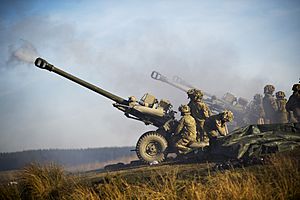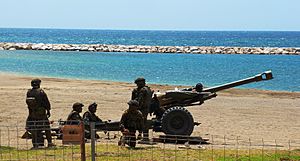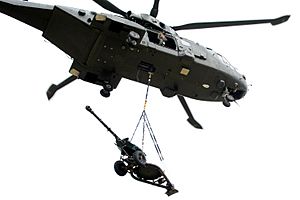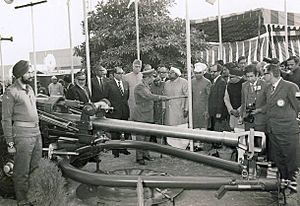L118 light gun facts for kids
Quick facts for kids Gun, 105mm, field, L118 |
|
|---|---|

Royal Artillery firing 105 mm light guns on exercise in 2013
|
|
| Type | Towed field gun |
| Place of origin | United Kingdom |
| Service history | |
| In service | 1974-present |
| Used by | See Operators |
| Wars |
|
| Production history | |
| Designer | Royal Armament Research and Development Establishment |
| Designed | 1966-1973 |
| Manufacturer | Royal Ordnance Factory (later BAE Systems Land and Armaments) |
| Produced | 1974-2016 |
| No. built | Over 1,100 |
| Variants |
|
| Specifications (L118) | |
| Mass | 1,982 kg (1.951 long tons) |
| Length | 7.01 m (23 ft) firing 4.876 m (16 ft) travelling |
| Barrel length | 3.9 m (12 ft 10 in) L/37 |
| Width | 1.778 m (5 ft 10 in) |
| Height | 1.371 m (4 ft 6 in) travelling |
| Crew | 6 (minimum 3) |
|
|
|
| Shell |
|
| Calibre | 105 mm (4.1 in) |
| Barrels | L19 ordnance |
| Breech | Vertical sliding block |
| Recoil | Hydro-pneumatic |
| Carriage | L17 box trail carriage with circular firing platform |
| Elevation |
|
| Traverse |
|
| Rate of fire | 12 rds/min rapid 3 rds/min sustained |
| Maximum firing range |
|
| Sights |
|
| References | Janes & BAE Systems |
The L118 light gun is a powerful howitzer (a type of artillery gun) that can be pulled by vehicles. It was first designed and built in England for the British Army in the 1970s. Since then, many countries around the world have bought it. The L119 and the United States Army's M119 are similar versions that use a different kind of ammunition.
Contents
History of the L118 Light Gun
How the Light Gun Was Developed
From 1961 to 1975, the British Army used a smaller 105 mm howitzer called the L5. This gun was light enough to be carried by helicopters or pulled by Land Rovers. It could even be taken apart for transport by animals like mules.
However, the L5 gun had some problems. It couldn't shoot very far, wasn't very strong, and its aiming tools weren't great. It also took too long to get ready to fire.
In 1965, the British Army decided they needed a new 105 mm gun. This new gun had to be able to turn all the way around (360 degrees) and weigh no more than about 1,588 kilograms (3,500 pounds). It also needed to fit inside new helicopters and transport planes.
The new gun was designed by the government's Royal Armament Research and Development Establishment (RARDE) in Kent. The first test versions were ready in 1968. Designers soon realized the gun needed to be a bit heavier to be strong enough.
Production of the L118 light gun began in 1975 at the Royal Ordnance Factory. Deliveries to the army started in 1976.
The L118 in British Military Service
The light gun joined the British Army in 1976. It was heavier than the old L5, but new helicopters like the Puma and Sea King could easily carry it. A special vehicle, the Land Rover 101 Forward Control, was made to pull the gun. Today, the British Army uses Pinzgauer ATVs to tow these guns. In cold places, the gun can be pulled by a Bv 206 vehicle and even fitted with skis for snow.
In 1982, 30 light guns were sent to the Falkland Islands during the Falklands War. During the final battles, these guns fired up to 400 rounds per gun each day. They played a very important part in the British victory.
Today, the British Army has several regiments that use the light gun. It is also used for training new soldiers at the Royal School of Artillery.
On November 30, 2001, an L118 light gun became the famous One O'Clock Gun at Edinburgh Castle. This gun fires every day at 1 PM, except on Sundays, Good Friday, and Christmas Day.
As of July 2017, the British Army had 126 L118 light guns in use.
How the L118 Light Gun Is Designed
The L118 light gun uses a special barrel called the L19. This barrel is made stronger and lighter using a process called autofrettage.
The light gun has some design features similar to older British guns, like its vertical sliding block breech. Its light weight comes from the special steel used and other clever design choices.
Because of its narrow design, the gun's barrel cannot easily turn all the way around for towing. So, one wheel can be removed to allow the barrel to rotate. A trained crew can do this in about 30 seconds.
When the gun was first used, soldiers aimed it using an optical sight called the L7. Now, these older sights are mostly used for training.
The guns also have a special telescope for aiming directly at targets. They used to have night vision scopes too.
Ammunition Used by the L118
The L118 light gun uses 105 mm Fd Mk 2 ammunition. This ammunition comes in two parts: the shell and the propellant cartridge. The shell is loaded first, then the cartridge with the gunpowder.
Different types of shells are used for different purposes:
- L31 HE (High Explosive): These shells explode with great force. They are said to be more powerful than similar US shells.
- L45 Smoke: These shells create thick white smoke to hide troop movements or targets.
- Target Marker: These shells burst in the air or on impact, creating bright orange or red clouds. They are used to mark targets, for example, for air attacks.
- L43 Illuminating: These shells release a flare that hangs in the air by a parachute. It burns brightly for about 30 seconds to light up an area at night.
- L42 HESH (High Explosive Squash Head): These are used for direct firing against armored vehicles or buildings.
- L50A2 HE-IM ER: This is an extended-range high-explosive shell that can fly farther, up to about 20.6 kilometers (12.8 miles).
Upgrades and Improvements
In the early 1990s, all UK L118 guns received a device to measure how fast the shell leaves the barrel. This radar system helps with aiming.
In 2002, the British Army's L118 guns got a new aiming system called LINAPS. This system uses lasers and GPS to figure out exactly where the gun is pointing. It helps soldiers aim the gun very accurately without needing outside help.
New direct fire sights were added around 2010 for use in places like Afghanistan. These include a sniper's telescopic sight and a new night sight.
Different Versions of the L118
L119 Variant
The L119 is a version of the light gun with a slightly shorter barrel. It uses a different firing system and can fire the common US M1 type ammunition. This gives it a maximum range of about 11.4 kilometers (7.1 miles).
The British Army used the L119 only for training, and the last ones were retired in 2005. However, many other countries still use the L119 because they use M1 ammunition.
In 2022, soldiers from New Zealand went to the United Kingdom to train Ukrainian soldiers on the L119 light gun. New Zealand also gave about forty aiming sights to Ukraine.
M119 Howitzer
The L119 was further changed and built under license for the United States Army. The newest version, the M119A3, came out in 2013. It has a digital fire-control system and uses GPS for navigation, similar to the larger M777A2.
Other Light Gun Versions
- During the 1970s, a third version, the L21, was developed for Switzerland, but it was never put into service.
- The Indian 105 mm light field gun looks very similar to the UK's L118.
- In 1984, Australia started using the L119, calling it the "Hamel gun." It was built in Australia for both the Australian and New Zealand armies.
- The British Army also has special 105 mm saluting guns for ceremonies. These are L118s modified to fire only blank cartridges. They are painted bronze green and have shiny parts.
Countries That Use the L118
Current Users

 Bahrain: 8 L118
Bahrain: 8 L118 Benin: 12 L118
Benin: 12 L118 Bosnia-Herzegovina: 36 L118
Bosnia-Herzegovina: 36 L118 Botswana: 12 L118
Botswana: 12 L118 Brazil: 40 L118 (Army) and 18 L118 (Naval Fusiliers)
Brazil: 40 L118 (Army) and 18 L118 (Naval Fusiliers) Ireland: 24 L118 and 6 L119
Ireland: 24 L118 and 6 L119 Kenya: 40 L118
Kenya: 40 L118 Malawi: 9 L118
Malawi: 9 L118 Morocco: 30 L118
Morocco: 30 L118 Nepal: 8 L118
Nepal: 8 L118 New Zealand: 24 L119
New Zealand: 24 L119 Oman: 42 L118
Oman: 42 L118 Portugal: 21 L119
Portugal: 21 L119 Spain: 56 L118
Spain: 56 L118 Thailand: 60 L119 – Royal Thai Army received a domestic production patent
Thailand: 60 L119 – Royal Thai Army received a domestic production patent United Arab Emirates: 73 L118
United Arab Emirates: 73 L118 United Kingdom: 126 L118 (Army)
United Kingdom: 126 L118 (Army) Ukraine: 36 L119 and 72 of unspecified variant provided by the US (16 in August 2022, 4 in September 2022, 16 in October 2022, 36 in January 2023)
Ukraine: 36 L119 and 72 of unspecified variant provided by the US (16 in August 2022, 4 in September 2022, 16 in October 2022, 36 in January 2023) United States: 821 M119A2/A3 (72 given to Ukraine)
United States: 821 M119A2/A3 (72 given to Ukraine)
Past Users
 Australia (111 L119, stopped using them in 2014; 92 were sold to British company BAE Systems in 2018)
Australia (111 L119, stopped using them in 2014; 92 were sold to British company BAE Systems in 2018) Netherlands (8 L118 borrowed from the United Arab Emirates in 1995)
Netherlands (8 L118 borrowed from the United Arab Emirates in 1995) South Korea (2 L118 for testing in June 1976)
South Korea (2 L118 for testing in June 1976) Switzerland (6 L127A1 test versions delivered 1979–1981)
Switzerland (6 L127A1 test versions delivered 1979–1981)
See also
 In Spanish: Cañón ligero L118 para niños
In Spanish: Cañón ligero L118 para niños
- Airborne gun
- GIAT LG1 howitzer, France
- KH178 howitzer, South Korea






